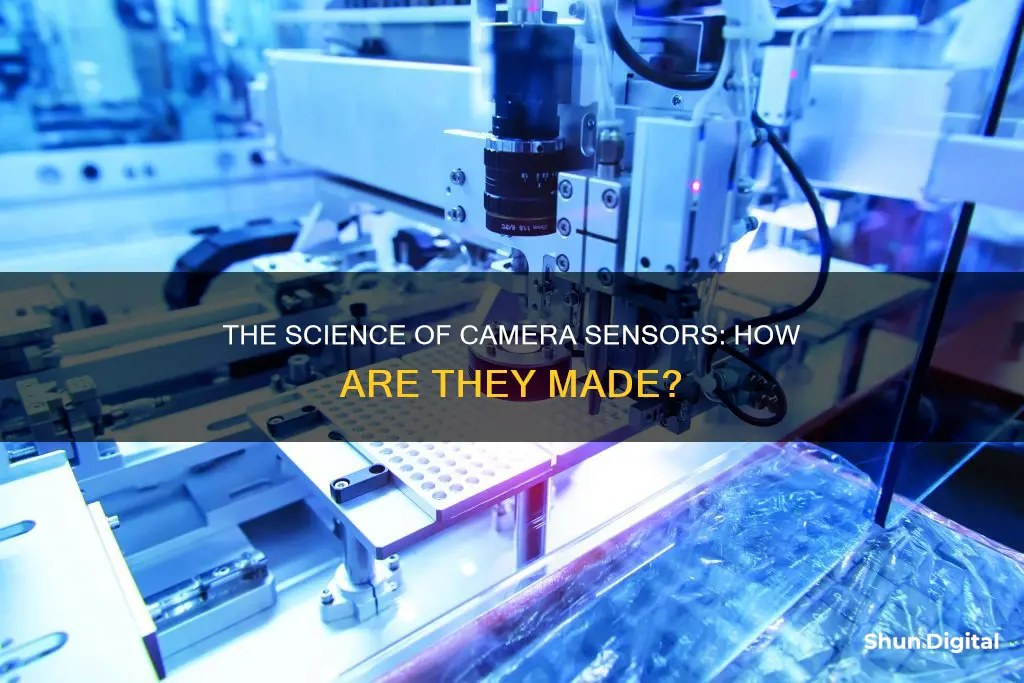
Camera sensors are an essential component of digital cameras, enabling them to capture light and produce images. There are two main types of camera sensors: Complementary Metal-Oxide Semiconductors (CMOS) and Charge-Coupled Devices (CCD). CMOS sensors are commonly found in consumer goods and still photography, while CCD sensors are used in high-end broadcast equipment. Both CMOS and CCD sensors are constructed from silicon, sharing similar properties in the visible and near-IR spectrum. They convert incident light into electrical charges through the photoconversion process. The manufacturing process involves forming sensors on silicon wafers and then cutting them apart. This paragraph introduces the topic of camera sensor manufacturing, delving into the types, functions, and production techniques of these crucial components in digital imaging technology.
| Characteristics | Values |
|---|---|
| What are camera sensors made of? | Silicon wafers |
| How are they made? | Image sensors are formed on silicon wafers and then cut apart. |
| What do they do? | Sensors detect and convey information used to form an image by converting the variable attenuation of light waves into electrical signals. |
| What are the two main types of electronic image sensors? | Charge-coupled device (CCD) and active-pixel sensor (CMOS) |
| What are the two basic kinds of CMOS image sensors? | Passive-pixel sensors (PPS) and active-pixel sensors (APS) |
| What are the cavities in the sensors called? | Photosites |
| What is the most common type of color filter array? | Bayer array |
What You'll Learn

CMOS vs. CCD image sensors
Camera sensors are made up of millions of cavities called "photosites" or "photodiodes". When the shutter opens, these photosites open to capture photons, which are then converted into electrical signals. This process is the same for both CMOS and CCD sensors, but there are some key differences in how these sensors are made and how they function.
CMOS (Complementary Metal-Oxide Semiconductor) sensors are the most common type of image sensor and are used in most modern devices, including mobile phones, robotics and warehouse automation, and digital cameras. CMOS sensors have an amplifier in each pixel, resulting in lower power consumption and faster processing speeds. They are also more cost-effective to manufacture and more compact and lightweight than CCD sensors. However, the presence of additional amplifiers can generate more noise in the output image, and CMOS sensors tend to have lower light sensitivity.
CCD (Charge-Coupled Device) sensors, on the other hand, are typically used in older camera models and high-end broadcast-quality video cameras. They are known for producing high-quality, low-noise images with increased light sensitivity. CCD sensors are analog devices that employ a charge transfer process to capture images. Each pixel in a CCD sensor consists of a photodiode and a potential well, which act as a receptacle for photoelectrons. However, they consume significantly more power and are more expensive to manufacture than CMOS sensors.
In recent years, CMOS sensors have seen improvements in image quality, low-light sensitivity, dynamic range, and quantum efficiency, making them increasingly competitive with CCD sensors. As a result, CMOS sensors are now preferred in many applications due to their lower cost, higher performance, and ongoing innovations.
Diagnosing Camera Battery Issues: Is It Time for a Replacement?
You may want to see also

How camera sensors work
Camera sensors, also known as image sensors, are a crucial component of digital cameras, enabling them to capture light and create images. There are two main types of camera sensors: Charge-Coupled Devices (CCD) and Complementary Metal-Oxide Semiconductors (CMOS). Both types of sensors have their unique characteristics and are used in different types of cameras.
CCD sensors were the first type of image sensors used in digital cameras and are still found in some modern cameras. They work by capturing light on small cavities called photosites. When the shutter button is pressed, these photosites open up, allowing photons to enter and be stored as an electrical charge. After the exposure is finished, the camera closes the photosites and measures the strength of the electrical signal to determine the number of photons captured. This information is then processed to create a grayscale image. To capture colour images, a Bayer filter array is used, which consists of red, green, and blue filters placed over the photosites to determine the colour of the image.
On the other hand, CMOS sensors are newer and more commonly used in consumer goods due to their lower cost and power consumption. CMOS sensors are also capable of performing camera functions on-chip. They work similarly to CCD sensors by capturing light and converting it into an electrical signal. However, CMOS sensors have an amplifier for each pixel, resulting in a smaller area for photon capture. This issue has been addressed by using microlenses in front of each photodiode to focus light and improve photon capture.
Both CCD and CMOS sensors have their advantages and disadvantages. CCD sensors are known for their excellent image quality and are used in high-end broadcast cameras. In contrast, CMOS sensors offer lower power consumption and are more cost-effective, making them dominant in still photography and consumer goods.
In summary, camera sensors work by capturing light through photosites, converting it into electrical signals, and processing this information to create an image. The two main types of sensors, CCD and CMOS, differ in their structure and applications but ultimately serve the same purpose of capturing light and creating images.
Outdoor Game Motion Cameras: How Long Do Batteries Really Last?
You may want to see also

Bayer filter arrays
The Bayer filter is a colour filter array (CFA) or colour filter mosaic, consisting of a mosaic pattern of tiny colour filters placed over each photosensor. The filters are arranged in a 2x2 block of pixels, with a proportion of two green filter elements for each red and blue filter element, resulting in a pattern that is half green, one quarter red, and one quarter blue. This arrangement, also known as RGGB, mimics the human retina's higher sensitivity to green light during daytime vision.
The Bayer filter's unique pattern allows the camera to capture colour information by filtering the light that reaches each photosensor. The red filter captures red light, the blue filter captures blue light, and the green filter captures green light. However, this process also results in the loss of two-thirds of the light, as only one colour is captured by each photosensor. This limitation forces the camera to estimate the amounts of the other two colours for each pixel, contributing to potential inaccuracies in colour reproduction.
To address this challenge, a process called demosaicing is employed. Demosaicing involves using various algorithms to interpolate and estimate the full colour values for each pixel. The simplest demosaicing algorithms average the input from neighbouring pixels of the same colour to determine the colour value for a given pixel. For example, a pixel recording green may use the information from two nearby pixels recording red and two recording blue to estimate its full colour value.
While this basic demosaicing technique works well in areas of constant colour or smooth gradients, it may struggle in high-contrast areas with abrupt colour changes, potentially leading to colour bleeding and other artefacts like zippering. More advanced demosaicing algorithms have been developed to address these challenges, making complex assumptions about colour correlations and image content to improve colour accuracy.
Undoing Actions: Camera Raw's Secret Superpower
You may want to see also

Passive- and active-pixel sensors
The passive-pixel sensor (PPS) is a precursor to the active-pixel sensor (APS). A PPS consists of passive pixels that are read without amplification, with each pixel made up of a photodiode and a MOSFET switch. The photodiode array, which forms the basis of the PPS, was proposed by G. Weckler in 1968.
Passive-pixel sensors were investigated as a solid-state alternative to vacuum-tube imaging devices. The MOS passive-pixel sensor used a simple switch in the pixel to read the photodiode integrated charge. However, passive-pixel sensors had limitations such as high noise, slow readout, and lack of scalability.
The active-pixel sensor, on the other hand, consists of active pixels, each containing one or more MOSFET amplifiers that convert the photo-generated charge to a voltage, amplify the signal voltage, and reduce noise. The concept of an active-pixel device was proposed by Peter Noble in 1968.
The NMOS active-pixel sensor (APS) was invented by Olympus in Japan in the mid-1980s, enabled by advances in MOS semiconductor device fabrication. The first NMOS APS was fabricated by Tsutomu Nakamura's team at Olympus in 1985.
The CMOS active-pixel sensor (also known as the CMOS sensor) emerged as an alternative to charge-coupled device (CCD) image sensors and eventually outsold them by the mid-2000s. CMOS sensors are used in various digital camera technologies, such as cell phone cameras, web cameras, digital single-lens reflex cameras (DSLRs), and mirrorless interchangeable-lens cameras (MILCs).
CMOS sensors offer several advantages over CCD sensors, including lower production cost, better control of blooming (bleeding of photo-charge from an over-exposed pixel), and the ability to combine image sensor and image processing functions within the same integrated circuit.
Trail Camera Power: Battery or Solar?
You may want to see also

The future of CMOS image sensors
The CMOS image sensor has already revolutionized the way we capture images, but what does the future hold for this technology?
CMOS sensors have become the dominant force in digital imaging, surpassing CCD sensors in the 2010s due to their lower cost, greater energy efficiency, and improved image quality. The future of CMOS image sensors will see continued enhancements in several key areas, building on the solid-state semiconductor foundation laid by MOS technology.
One area of focus is the digital image processing capabilities of the sensor chip. Experts predict that further development in this area will lead to even better digital images. Additionally, there is ongoing work to explore different geometries for the photodiode, with researchers testing the use of cyan-yellow-magenta (CYM) filters instead of the traditional red-green-blue (RGB) filters. This change could result in greater sensitivity and stronger electrical signals, potentially enhancing the overall performance of the sensor.
Another area of improvement is low-light sensitivity, which is crucial for applications such as night vision and astronomy. CMOS sensors are already making inroads into high-end applications that require low noise and greater sensitivity, such as photo-astronomy and microscope cameras, which were once the domain of CCD sensors. The advancements in CMOS technology are also impacting the automotive industry, with the proliferation of megapixel video cameras in vehicles, enhancing driver awareness and supporting autonomous driving systems.
The ever-increasing pixel count on mobile phone cameras is another testament to the advancements in CMOS sensor technology. As feature sizes decrease, architects can pack more pixels into smaller areas, resulting in higher-resolution images without increasing the physical size of the camera module. This trend is set to continue, with consumers demanding sharper and more detailed images from their devices.
In summary, the future of CMOS image sensors looks bright, with ongoing improvements in semiconductor manufacturing technologies and digital image processing. These advancements will continue to push the boundaries of what is possible in digital imaging, making CMOS sensors even more versatile, powerful, and ubiquitous in the years to come.
iPhone XS Max: Night Mode Camera Feature Explained
You may want to see also
Frequently asked questions
A camera sensor is a device that detects and conveys information to form an image. It does so by converting the variable attenuation of light waves into electrical signals.
Camera sensors work by capturing light and producing electrical signals that the processor in the camera reads and interprets as colours.
The two main types of camera sensors are Complementary Metal Oxide Semiconductor (CMOS) and Charge-Coupled Device (CCD). CMOS sensors are typically used in cameras integrated into small consumer products, while CCD sensors are used in high-end broadcast-quality video cameras.
Image sensors are made from silicon wafers, which are formed into chips that capture and read light. The silicon wafers are manufactured in wafer foundries or fabs, where tiny circuits and devices are etched onto the silicon chips.







